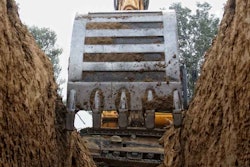
While much of the focus of the recently passed $1.9 trillion Covid relief package has been on stimulus payments and unemployment benefits, the new law signed by President Joe Biden includes provisions that should help construction contractors.
One of the biggest provisions is $350 billion in additional funding to state and local governments to help recoup some of the lost revenues and additional expenses caused by the pandemic. Though it does not specifically call on spending the money on capital projects, roads and other infrastructure, construction industry advocates say it should help keep such projects at least on track by taking pressure off state and local budgets.
“These new resources will greatly assist municipalities without having to choose between critical Covid-19 health services and must-have projects such as new water or wastewater lines,” says the National Utility Contractors Association.
“The broad authority given to states and localities for the use of this assistance takes pressure off transportation budgets and could allow some funds to flow to infrastructure-related activities,” says the American Road and Transportation Builders Association.
States will split $195 billion of the funding, and counties and cities will get $130 billion. (To see ARTBA’s state, city and county breakdown of how the funding will likely be split, click here.)
The American Rescue Plan that President Joe Biden signed into law on March 11 also includes:
- $30.5 billion for public transportation agencies to offset lost revenue from fewer riders and other Covid-related factors.
- $10 billion for states to use on capital projects for work, education and health monitoring. NUCA says this could be used to expand broadband infrastructure.
- $8 billion for airports to help with operating and other costs associated with revenue declines. NUCA says this could also lead to renovations of airport facilities to prevent the spread of coronavirus.
The plan adds $7.25 billion to the Paycheck Protection Program for forgivable loans and $15 billion to the Small Business Administration’s emergency disaster loan program. Contractors have been participating in both of these programs during the pandemic.
Another possible boost for contractors is the continuation of tax credits for employers who provide paid sick and family leave. A temporary law enacted last year during the pandemic requiring up to two weeks of paid sick leave and 10 weeks of family leave expired in December, but those who voluntarily provide the benefit remain eligible for the tax credits.
The plan also provides indirect help to the construction industry – as well as the nation – by proving $160 billion for coronavirus vaccine and testing programs, including free vaccines for all U.S. residents. NUCA notes that this provision includes helping local jurisdictions implement testing programs and expand lab capacities. “Expanding these programs will allow essential industries like utility construction to ensure the good health of their employees on and off the jobsite,” NUCA says.
ARTBA also notes another indirect – and hopeful – benefit of the relief plan:
“The measure also marks what many hope will be the last relief bill, signaling a shift to economic recovery with a focus on infrastructure investment.”












